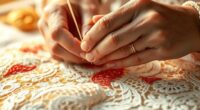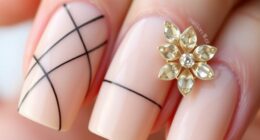In a couture collection, your money mainly goes toward building a luxurious brand image, sourcing premium fabrics, and paying skilled artisans for craftsmanship. You’ll also invest in high-end marketing efforts like exclusive photoshoots, runway shows, and collaborations to boost desirability. Production costs cover prototypes, fittings, and refinement to guarantee top quality. If you want to understand how each dollar shapes your collection’s exclusivity and appeal, keep exploring these key areas.
Key Takeaways
- Significant investment in luxury branding to establish exclusivity and enhance brand prestige.
- Funds allocated for sourcing high-quality materials and employing skilled artisans for craftsmanship.
- Expenses for marketing activities, including photoshoots, runway shows, and influencer collaborations.
- Costs associated with multiple prototypes, fittings, and ensuring high standards in production.
- Strategic financial planning to align spending with brand goals and attract high-end clientele.

Creating a couture collection involves significant financial planning and strategic investment. You need to understand where your money will go, guaranteeing every dollar spent aligns with your vision and business goals. When developing a couture line, luxury branding becomes a core focus, as building a strong brand identity requires substantial investment in quality materials, craftsmanship, and marketing. Establishing a reputation for exclusivity and sophistication isn’t cheap, but it’s essential to attract high-end clients who value artistry and rarity. You’ll allocate funds toward branding efforts such as logo design, packaging, and a compelling brand story that resonates with your target audience. These elements are critical for positioning your collection as a luxury item, and they directly influence your fashion marketing strategies, which are designed to elevate your brand’s visibility and desirability.
A significant portion of your budget will go into sourcing premium fabrics and materials. Couture is all about meticulous detail and the finest textiles, so you’ll spend generously on textiles that convey luxury and durability. Skilled artisans and couturiers demand competitive wages, and their craftsmanship is an investment in the quality and exclusivity of your collection. You’ll also need to budget for pattern making, fitting sessions, and multiple prototypes to perfect each piece. All these steps guarantee that the final product meets the high standards expected in the luxury fashion industry. Additionally, understanding the importance of natural materials in creating authentic and high-quality garments can help justify certain expenses.
Marketing your couture collection is another major expense. You’ll allocate funds toward fashion marketing campaigns, including high-end photoshoots, runway shows, and exclusive events that showcase your collection to the right audience. Building buzz around your brand requires strategic publicity, often involving collaborations with influencers, stylists, and fashion editors who can elevate your profile. Social media advertising and digital marketing are essential in today’s landscape, so you’ll invest in targeted campaigns to reach affluent consumers worldwide. Remember, in luxury branding, the narrative you craft around your collection influences perceptions and desirability, making marketing spend a key component of your financial planning.
Frequently Asked Questions
How Do Couture Houses Fund Their Collections?
You might wonder how couture houses fund their collections. They typically rely on a mix of luxury branding and exclusivity, which attracts wealthy clients willing to invest heavily. These houses also utilize artisanal craftsmanship, showcasing the skill and uniqueness of each piece, justifying high prices. Additionally, they may seek sponsorships, partnerships, and sometimes pre-orders to cover production costs, ensuring their haute couture remains both prestigious and financially sustainable.
What Are the Main Revenue Sources for Couture Brands?
You’ll find that the main revenue sources for couture brands stem from luxury branding and customer exclusivity. When you indulge in their creations, you’re paying for more than just a garment; you’re investing in an exclusive experience. Haute couture houses often earn through bespoke pieces, limited-edition collections, and personalized services. These elements create a sense of rarity, allowing them to command premium prices, and ensuring their revenue remains as refined as their designs.
How Much Profit Do Couture Collections Typically Generate?
You might wonder how much profit couture collections usually make. While the exact numbers vary, these collections often generate significant profit due to luxury branding and client exclusivity. You’ll find that high prices and limited editions help maximize earnings. However, keep in mind that the focus remains on maintaining brand prestige and delivering unique, handcrafted pieces, which can sometimes mean profits are balanced against the costs of exclusivity and craftsmanship.
What Are the Biggest Costs in Creating Couture Pieces?
You’ll find the biggest costs in creating couture pieces are luxury craftsmanship and fabric sourcing. High-end artisans spend countless hours perfecting each detail, which drives up labor costs. Additionally, sourcing rare, exquisite fabrics adds to expenses, as they’re often custom-made or very limited. These elements guarantee the exclusivity and quality of couture, but they also markedly increase the overall production costs, making each piece a true investment in luxury.
How Do Couture Brands Handle Financial Risk?
You manage financial risk in couture by focusing on luxury branding to maintain exclusivity and appeal. By cultivating strong customer loyalty through personalized experiences and high-quality craftsmanship, you guarantee repeat business and a steady revenue stream. This strategy helps mitigate the unpredictable costs and market fluctuations inherent in couture, allowing you to sustain your brand’s prestige while safeguarding your financial stability.
Conclusion
Understanding where your money goes in a couture collection is like tending a delicate garden—you must nurture each detail carefully. Just last season, a designer’s meticulous investment in rare fabrics and skilled artisans paid off when their show sold out instantly. By knowing how funds flow—from design to execution—you become the master gardener of your own fashion empire. Stay mindful of every dollar, and watch your couture garden flourish into something truly extraordinary.










